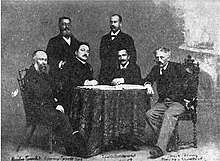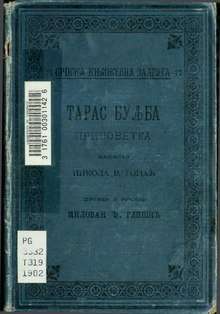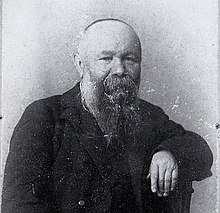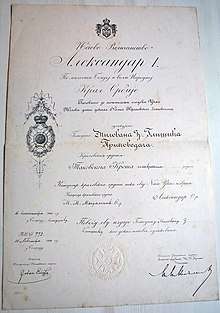Milovan Glišić
Milovan Glišić (6 January 1847 – 20 January 1908) was a Serbian writer, dramatist, translator, and literary theorist. He is sometimes referred to as the Serbian Gogol.
Milovan Glišić | |
|---|---|
.jpg) | |
| Born | 6 January 1847 Gradac, Valjevo, Ottoman Empire |
| Died | 20 January 1908 (aged 61) Dubrovnik, Austria-Hungary |
| Occupation | Writer, translator, dramatist, newspaperman |
| Language | Serbian |
| Nationality | Serbian |
| Alma mater | University of Belgrade |
| Period | realism |
| Notable works | Glava šećera, Posle devedeset godina |
| Notable awards | Order of St. Sava, Order of the Cross of Takovo |
| Spouse | Kosara Stefanović |
Biography
Glišić was born in the farming community of Gradac, near Valjevo in the Kolubara District, Serbia, to Đorđe and Jevrosima Glišić. He had to begin work at an early age to support himself and the family, but he still managed to have a good education. Glišić was educated at Belgrade's Grandes écoles, from which he graduated in 1875. During the Serbo-Turkish War of 1875, Glišić worked in the Press Bureau of the Foreign Ministry at Belgrade. After the death of poet-painter Đura Jakšić in 1878 he succeeded Jakšić as editor of the National Printing Press. He was also managing editor of Srpskih Novina (Serbian Newspapers) on two occasions. One of the many younger writers to whom, as editor and critic Glišić gave encouragement, was Laza Lazarević. While still in college, he met literary critic Svetozar Marković, who exerted an influence on him at the very beginning of his career as a journalist and translator. From 1881 to 1898 Glišić was the dramaturge of the National Theatre in Belgrade (founded in 1868 by Jovan Đorđević), then under the direction of Milorad Popović Šapčanin. Both Glišić and Šapčanin got along extremely well. In fact, under their leadership the National Theatre began to thrive for the first time, offering quality performances at popular prices and convenient times for the general public. In 1898, Milovan Glišić's increasing popularity, as an author and translator par excellence enabled him to retire from public service. Two years later (1900), however, he returned to take the post of director of Belgrade's National Library of Serbia. For health reasons, he went to Dubrovnik, where he died, aged 61.
Literary career

The era of romantic patriotic enthusiasm gave way in the seventies to a period of realism in both literature and art. Glišić was the first Serbian prose realist who dealt with rural themes and the patriarchal milieu. He was also the first distinctive writer from Serbia who joined Svetozar Marković's movement in literature as well as politics, criticizing the establishment. Soon other men of letters became fervent exponenets of these new trends and ideas. Some prominent Serbian realists, Janko Veselinović, Laza Lazarević, Svetolik Ranković and Milovan Glišić, influenced by Marković's ideas, wrote short stories often based on village settings, reflecting traditional patriarchal values contrary to the dehumanizing effect of rapid urbanization and early industrialization.
Glišić began his literary translations in satirical newspapers, and then went on to write original short stories. His original work includes two theater pieces about village life in Serbia, Two Farthings (Dva cvancika, 1882) and The Hoax (Podvala, 1885). Though both plays are treated as comedies, they contain a great deal of social criticism of corruption, bureaucracy, and exploitation of peasants by city dwellers. And, two collections of short stories. They include, among others, his most popular humorous and satirical stories: Roga, Not About What, Pricker for Fire, One Good Turn Deserves Another, The Musician, Walk After Death, An Ominous Number. His best stories, however, are: Glava secera (Sugarloaf); Redak zver (A Rare Animal); and Prva brazda (The First Furrow). Based on peasant life and often built upon popular legend, his stories accurately depict the life of the down-trodden and poor in the Balkans, exposing the usurers, and the insincere love of the ruling class for the common folk. The acridity of his criticism is far more muted in his later works.
Translations

Glišić specialized in translating from Russian and French literatures and in the 1880s he was looked upon as the best of the foreign language translators in Serbia, along with Ljubomir Miljković, his collaborator. Their collaboration followed by a series of editions of Russian classics and of books and articles on the history of Russian literature, which made him the most prominent Serbian authority on the subject. His studies in French contemporary literature were no less comprehensive, and included the valuable revisions of certain editions. As a conscientious and talented translator, and also a great connoisseur of living languages, he enabled writers in these languages, especially the Russians and Ukrainians, to exert a considerable influence on Serbian writers and poets (the same way he was influenced by Gogol). Due credit, indeed, must be given to him for familiarizing the Serbian reading audience with the great 19th Century Russian authors, and significantly influencing the development of his translations of literary language and style.
The best and most important of his translations from Russian and Ukrainian are: Dead Souls and Taras Bulba by Nikolai Gogol, The Kreutzer Sonata and War and Peace by Leo Tolstoy (with collaborator Okica Gluščević) Oblomov by Ivan Goncharov, and other works by Alexander Ostrovsky, Ignaty Potapenko, Vladimir Nemirovich-Danchenko, Alexander Pushkin, Mariya Vilinska (better known as Marko Vovchok, her nom de plumme), Nikolai Schedrin, Vsevolod Garshin, Anton Chekhov, Taras Shevchenko, Ivan Turgenev, Fyodor Dostoyevsky, Maksim Gorky and writer-painter Nikolai Leykin. From the French he had translated some of the works of Balzac, Prosper Mérimée's Colomba, Jules Verne's Une Fantaisie du Docteur Ox (Doktor Oks i njegova posla), Ludovic Halévy, Victorien Sardou, Maurice Maeterlinck (Princess Maleine), Alphonse Daudet (Tartarin de Tarascon and Le Nabab), Erckmann-Chatrian (Hugues-le-loup, Les Deux Frères, and L'Invasion ou le Fou Yégof), Émile Augier (Le Fils de Giboyer and La pierre de touche), Jules Sandeau, Eugène Scribe, Edouard Foussier, Eugène Marin Labiche, Henri Meilhac, Georges Feydeau and others. He also translated the works of American authors, particularly Mark Twain. He made the first Serbian translation of a short story by Edgar Allan Poe.[1]
For the Serbian theater he had translated more than thirty-one plays from Russian, French, and German literatures.
Stories
Milovan Glišić was known mostly for his realist stories, but he also had a few which included horror motifs of Serbian folklore and superstition. The most famous one is "After Ninety Years" (1880), published some 17 years before Bram Stoker's Dracula. Glišić based his story on the folktales and folk beliefs of villagers in the mountains of western Serbia along the Drina River valley. As such, it represents a treasure trove of ethnographic information and offers insights into authentic vampire lore before the creation of the modern pop culture vampire. The language Glišić employs is the vernacular of the common rural population in the mountainous regions of western Serbia along the Drina River valley in the 18th and 19th centuries. In contrast to the heavily ornamented and wordy prose so common among his contemporaries in Russia and the west, Glišić deliberately wrote in a sparse, plain, and raw style, accurately reflecting the mannerisms of village life and culture, an approach used by Mark Twain in "The Celebrated Jumping Frog of Calaveras County." Similar to 19th century American author Washington Irving's "The Legend of Sleepy Hollow" or "Rip Van Winkle", Glišić mined local folklore to retell the story of the vampire Sava Savanović. As such, the text presents a wealth of ethnographic material. Glišić offers valuable insights into the roles of women and children in the traditional patriarchal Serbian zadruga, a family-based agricultural cooperative that formed the basis of village life. The role of alcohol in hospitality, causing and settling disputes is also quite evident. And village gossip plays an important role in the everyday life of both men and women. Of particular note is Glišić's description of the folk beliefs surrounding vampires, how they are found, how they are killed, the forms they take, their physical appearance, etc. In this, Glišić accurately reflects folk beliefs still present today in many rural areas of the Balkans.

In Glišić's story the main character is Strahinja, a poor lad in 19th-century rural Serbia, who falls in love with a lovely daughter of a wealthy but ill-tempered Živan. He is almost driven from the village Žarozje when the village boss, the priest and a few village elders see an opportunity for Strahinja. The village is plagued by a vampire attacking the millers in an old mill: since no one dares to stay the night over there, the people are on the verge of famine. Strahinja agrees to do the job. Within the mill, he sets a trap for the vampire. On the cot on which the person caring for the mill sleeps, Strahinja places a log and covers it with blankets to give an appearance of a sleeping man, whilst he himself hides on the attic, armed with two rifles. Each is loaded with iron and stuffed silver coin, and thus he waits in ambush. As expected, the vampire does appear, and after discovering the ruse he loudly protests about being fooled (for the first time in 90 years, thus giving the story its title), revealing along with it his name – Sava Savanović – after which Strahinja shoots both of his rifles at him, yet when the smoke clears, no one is to be seen. The villagers are awed at the courage and cunning that Strahinja employed in dealing with the menace, yet the vampire is still alive, for the only way to kill him is to find the place he was buried and pierce his heart with a hawthorn stake. After some troubles, the villagers both determine who this Sava Savanović was (a horse thief) and manage to discover the vampire's grave. They pierce the (unopened) coffin with a stake, but due to clumsiness and fright of one of the company, a moth escapes from the coffin before it is drowned by pouring holy water. It is a being that coexists with the vampire, but whilst harmless to the grown-ups, it can cause disease amongst the children. The story ends on a happy note, with Živan finally giving consent to his daughter to marry Strahinja. The butterfly, though, for years following the slaying of Sava Savanović, caused disease and death of small children in the area where the story is set.[2]
Leptirica (1973), first Serbian horror movie, ia based on the story "After Ninety Years" written by Glišić.[3]
Legacy

Glišić is considered to be one of the best translators of his time and several of his short stories including Prva Brazda and Glava Šećera are studied in Serbian schools and included in various anthologies of short stories.[4][5] His translations of Russian writers Gogol and Tolstoy severely influenced Serbian culture of that time and future writers Stevan Sremac, Svetozar Ćorović, Branislav Nušić and many others.[6]
According to Slobodan Jovanović, Glišić was one of the first Serbian short story writers to attempt a more serious characterization in his works. [7]
He was awarded Order of the Cross of Takovo and Order of St. Sava of the third and the fourth class.[8]
Works
Comedies
- Two Farthings (Dva cvancika), 1882.
- The Hoax (Podvala), 1885.
Short stories
- Ni oko šta
- Vujina prosidba
- Učitelj
- Redak zver
- Tetka Desa
- Zlosutni broj
- Novi Mesija
- Glava šećera
- Prva brazda
- Posle devedeset godina
- Šetnja posle smrti
- U zao čas
- Svirač
- Raspis
- Sigurna većina
- Noć na mostu
- Nagraisao
- Roga
- Šilo za ognjilo
- Zadušnice
Translations
- Zla svekrva, Alexander Ostrovsky, 1881.
- Kola mudrosti, dvoja ludosti, Alexander Ostrovsky, 1882.
- Nov posao, Vladimir Nemirovich-Danchenko, 1883.
- Sve za sina, Emil Ožje, 1884.
- Naslednik, Emil Ožje, 1884.
- Gavran, Alphonse Daudet, 1888.
- La Peau de chagrin, Honoré de Balzac, 1888.
- Princess Maleine, Maurice Polydore-Marie-Bernard Maeterlinck, 1897.
- La Sanfelice, Alexandre Dumas, 1881.
- Plemićka, Fos, 1882.
- Dead Souls, Nikolai Gogol, 1872.
- Taras Bulba, Nikolai Gogol, 1876.
- Ivan Fyodorovich Shponka and His Aunt, Nikolai Gogol, 1870.
- Oblomov, Ivan Goncharov, 1876.
- The Kreutzer Sonata, Leo Tolstoy, 1890.
- War and Peace, Leo Tolstoy, 1899.
- Narodni borac, unknown author
- Polkanovi memoari, Nikolai Leykin
- Kolombo, Prosper Mérimée, 1877.
- Brđani, Erckmann-Chatrian, 1878.
- Dva brata, Émile Erckmann-Chatrian, 1878.
- Crna kuga, Émile Erckmann-Chatrian, 1878.
- Doctor Ox, Jules Verne, 1878.
- Tartarin of Tarascon, Alphonse Daudet
- Le Nabab, Alphonse Daudet
- The Man-wolf, Erckmann-Chatrian
- L’Invasion ou le Fou Yégof, Erckmann-Chatrian
- Ubistvo u ulici Morg, Edgar Allan Poe
- Srce izdajice, Edgar Alan Poe
- Strahovita noć
- Le Fils de Giboyer, Émile Augier
- La pierre de touche, Émile Augier
References
- https://www.vreme.com/cms/view.php?id=917285
- Ivanović, Ivan (2017-01-31). "Upokojeni Drainac".
- "Kadijević i srpski horor" (in Serbian). May 3, 2010. Retrieved 2 December 2012.
- Josić Višnjić, Miroslav, Filip Višnjić, Belgrade, 1999., p. 5.
- https://www.rastko.rs/knjizevnost/umetnicka/mglisic-price_c.html
- http://www.znanje.org/lektire/i22/04/02iv0420/o%20piscu.htm
- https://www.vreme.com/cms/view.php?id=917285
- http://www.novosti.rs/vesti/kultura.71.html:568955-Sabrana-dela-Milovana-Glisica-Znalac-srpske-duse
Sources
- Jovan Skerlić, Istorija nove srpske književnosi (Belgrade, 1921) pages 373–378
| Wikimedia Commons has media related to Milovan Glišić. |
